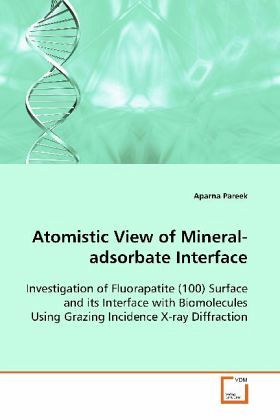
Atomistic View of Mineral-adsorbate Interface
Investigation of Fluorapatite (100) Surface and its Interface with Biomolecules Using Grazing Incidence X-ray Diffraction
Versandkostenfrei!
Versandfertig in 6-10 Tagen
45,99 €
inkl. MwSt.

PAYBACK Punkte
23 °P sammeln!
Apatite is an important biomineral, which constitutes the endoskeleton (bones and teeth) in vertebrates including humans. The interaction between the apatite surface and biological environment plays a key role in biomineralization. To understand the interaction between apatite and inorganic species, atomic scale information of the apatite surface and the apatite biomolecular interface is required. In this work, the structure of fluorapatite (100) surface was first investigated in dry environmental conditions using Grazing Incidence X-ray Diffraction (GIXRD). Further, to understand the apatite ...
Apatite is an important biomineral, which
constitutes the endoskeleton (bones and teeth) in
vertebrates including humans. The interaction
between the apatite surface and biological
environment plays a key role in biomineralization.
To understand the interaction between apatite and
inorganic species, atomic scale information of the
apatite surface and the apatite biomolecular
interface is required. In this work, the structure
of fluorapatite (100) surface was first investigated
in dry environmental conditions using Grazing
Incidence X-ray Diffraction (GIXRD). Further, to
understand the apatite biomolecular interface,
experiments were performed under humid and
completely hydrated conditions, which were then
followed by apatite aqueous glycine interface study.
Measurement and analyses of specular and non-
specular crystal truncation rods in all cases
provided information about the surface structure of
the mineral and sites of adsorption at the atomic
scale. Simulation studies supported the experimental
results.
constitutes the endoskeleton (bones and teeth) in
vertebrates including humans. The interaction
between the apatite surface and biological
environment plays a key role in biomineralization.
To understand the interaction between apatite and
inorganic species, atomic scale information of the
apatite surface and the apatite biomolecular
interface is required. In this work, the structure
of fluorapatite (100) surface was first investigated
in dry environmental conditions using Grazing
Incidence X-ray Diffraction (GIXRD). Further, to
understand the apatite biomolecular interface,
experiments were performed under humid and
completely hydrated conditions, which were then
followed by apatite aqueous glycine interface study.
Measurement and analyses of specular and non-
specular crystal truncation rods in all cases
provided information about the surface structure of
the mineral and sites of adsorption at the atomic
scale. Simulation studies supported the experimental
results.












